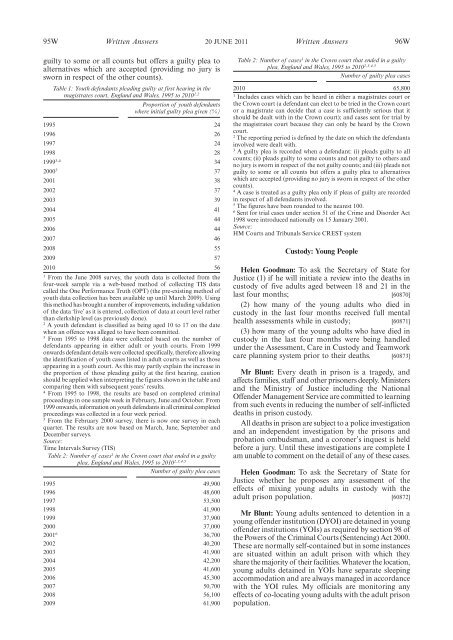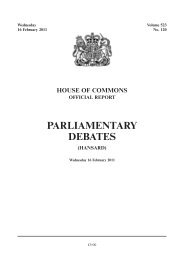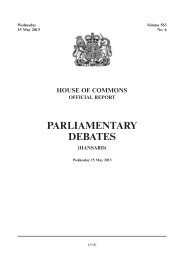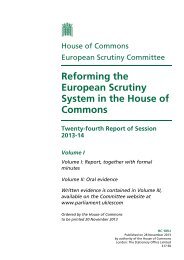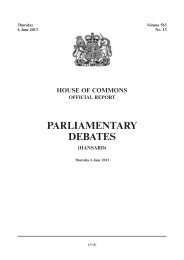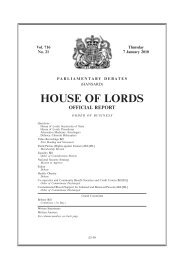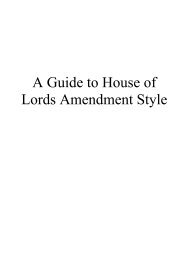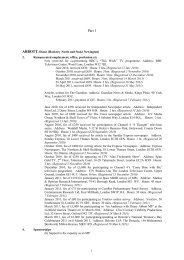Hansard - United Kingdom Parliament
Hansard - United Kingdom Parliament
Hansard - United Kingdom Parliament
You also want an ePaper? Increase the reach of your titles
YUMPU automatically turns print PDFs into web optimized ePapers that Google loves.
95W<br />
Written Answers<br />
20 JUNE 2011<br />
Written Answers<br />
96W<br />
guilty to some or all counts but offers a guilty plea to<br />
alternatives which are accepted (providing no jury is<br />
sworn in respect of the other counts).<br />
Table 1: Youth defendants pleading guilty at first hearing in the<br />
magistrates court, England and Wales, 1995 to 2010 1,2<br />
Proportion of youth defendants<br />
where initial guilty plea given (%)<br />
1995 24<br />
1996 26<br />
1997 24<br />
1998 28<br />
1999 3,4 34<br />
2000 5 37<br />
2001 38<br />
2002 37<br />
2003 39<br />
2004 41<br />
2005 44<br />
2006 44<br />
2007 46<br />
2008 55<br />
2009 57<br />
2010 56<br />
1<br />
From the June 2008 survey, the youth data is collected from the<br />
four-week sample via a web-based method of collecting TIS data<br />
called the One Performance Truth (OPT) (the pre-existing method of<br />
youth data collection has been available up until March 2009). Using<br />
this method has brought a number of improvements, including validation<br />
of the data ‘live’ as it is entered, collection of data at court level rather<br />
than clerkship level (as previously done).<br />
2<br />
A youth defendant is classified as being aged 10 to 17 on the date<br />
when an offence was alleged to have been committed.<br />
3<br />
From 1995 to 1998 data were collected based on the number of<br />
defendants appearing in either adult or youth courts. From 1999<br />
onwards defendant details were collected specifically, therefore allowing<br />
the identification of youth cases listed in adult courts as well as those<br />
appearing in a youth court. As this may partly explain the increase in<br />
the proportion of those pleading guilty at the first hearing, caution<br />
should be applied when interpreting the figures shown in the table and<br />
comparing them with subsequent years’ results.<br />
4<br />
From 1995 to 1998, the results are based on completed criminal<br />
proceedings in one sample week in February, June and October. From<br />
1999 onwards, information on youth defendants in all criminal completed<br />
proceedings was collected in a four week period.<br />
5<br />
From the February 2000 survey, there is now one survey in each<br />
quarter. The results are now based on March, June, September and<br />
December surveys.<br />
Source:<br />
Time Intervals Survey (TIS)<br />
Table 2: Number of cases 1 in the Crown court that ended in a guilty<br />
plea, England and Wales, 1995 to 2010 2,3,4,5<br />
Number of guilty plea cases<br />
1995 49,900<br />
1996 48,600<br />
1997 53,500<br />
1998 41,900<br />
1999 37,900<br />
2000 37,000<br />
2001 6 36,700<br />
2002 40,200<br />
2003 41,900<br />
2004 42,200<br />
2005 41,600<br />
2006 45,300<br />
2007 50,700<br />
2008 56,100<br />
2009 61,900<br />
Table 2: Number of cases 1 in the Crown court that ended in a guilty<br />
plea, England and Wales, 1995 to 2010 2,3,4,5<br />
Number of guilty plea cases<br />
2010 65,800<br />
1<br />
Includes cases which can be heard in either a magistrates court or<br />
the Crown court (a defendant can elect to be tried in the Crown court<br />
or a magistrate can decide that a case is sufficiently serious that it<br />
should be dealt with in the Crown court); and cases sent for trial by<br />
the magistrates court because they can only be heard by the Crown<br />
court.<br />
2<br />
The reporting period is defined by the date on which the defendants<br />
involved were dealt with.<br />
3<br />
A guilty plea is recorded when a defendant: (i) pleads guilty to all<br />
counts; (ii) pleads guilty to some counts and not guilty to others and<br />
no jury is sworn in respect of the not guilty counts; and (iii) pleads not<br />
guilty to some or all counts but offers a guilty plea to alternatives<br />
which are accepted (providing no jury is sworn in respect of the other<br />
counts).<br />
4<br />
A case is treated as a guilty plea only if pleas of guilty are recorded<br />
in respect of all defendants involved.<br />
5<br />
The figures have been rounded to the nearest 100.<br />
6<br />
Sent for trial cases under section 51 of the Crime and Disorder Act<br />
1998 were introduced nationally on 15 January 2001.<br />
Source:<br />
HM Courts and Tribunals Service CREST system<br />
Custody: Young People<br />
Helen Goodman: To ask the Secretary of State for<br />
Justice (1) if he will initiate a review into the deaths in<br />
custody of five adults aged between 18 and 21 in the<br />
last four months; [60870]<br />
(2) how many of the young adults who died in<br />
custody in the last four months received full mental<br />
health assessments while in custody; [60871]<br />
(3) how many of the young adults who have died in<br />
custody in the last four months were being handled<br />
under the Assessment, Care in Custody and Teamwork<br />
care planning system prior to their deaths. [60873]<br />
Mr Blunt: Every death in prison is a tragedy, and<br />
affects families, staff and other prisoners deeply. Ministers<br />
and the Ministry of Justice including the National<br />
Offender Management Service are committed to learning<br />
from such events in reducing the number of self-inflicted<br />
deaths in prison custody.<br />
All deaths in prison are subject to a police investigation<br />
and an independent investigation by the prisons and<br />
probation ombudsman, and a coroner’s inquest is held<br />
before a jury. Until these investigations are complete I<br />
am unable to comment on the detail of any of these cases.<br />
Helen Goodman: To ask the Secretary of State for<br />
Justice whether he proposes any assessment of the<br />
effects of mixing young adults in custody with the<br />
adult prison population. [60872]<br />
Mr Blunt: Young adults sentenced to detention in a<br />
young offender institution (DYOI) are detained in young<br />
offender institutions (YOIs) as required by section 98 of<br />
the Powers of the Criminal Courts (Sentencing) Act 2000.<br />
These are normally self-contained but in some instances<br />
are situated within an adult prison with which they<br />
share the majority of their facilities. Whatever the location,<br />
young adults detained in YOIs have separate sleeping<br />
accommodation and are always managed in accordance<br />
with the YOI rules. My officials are monitoring any<br />
effects of co-locating young adults with the adult prison<br />
population.


